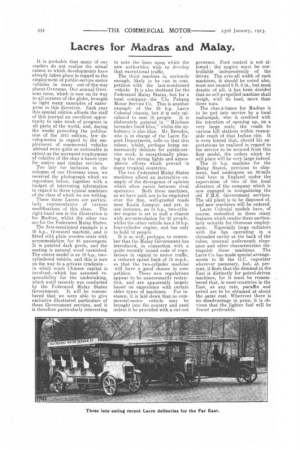Lacres for Madras and Malay.
Page 14

If you've noticed an error in this article please click here to report it so we can fix it.
It is probable that many of our readers do not realize the actual extent to which developments have already taken place in regard to the employment of public-service motor vehicles in many out-of-the-way places Overseas. Our annual Overseas issue, which is now on its way to all corners of the globe, brought to light many examples of enterprise in this direction. Each year this special edition affords the staff of this journal an excellent opportunity to take stock of progress in all parts of the world, and, during the weeks preceding the publication of the 1913 edition, few developments in regard to the employment of commercial vehicles abroad were quite so noticeable in extent as the increased employment of vehicles of the char--banes type for native and similar services.
Too late for inclusion in the columns of our Overseas issue, we received the photograph which we reproduce below, together with a budget of interesting information in regard to three typical machines of the class of which we are writing. These three Lacres are particularly representative of various modifications of this class. The right-hand one in the illustration is for Madras, whilst the other two are for the Federated Malay States.
The first-mentioned example is a 30 h.p., 12-seated machine, and is fitted with plain wooden seats with accommodation for -28 passengers, It is painted dark green, and the seating is natural wood varnished. The centre model is an 18 h.p., twocylindered vehicle, and this is now on the way to a private syndicatein which much Chinese capital is involved—which has assumed responsibility for the undertaking, which until recently was conducted by the Federated Malay States Government. It will be remembered that we were able to give exclusive illustrated particulars of these Government services, and it is therefore particularly interesting
to note the lines upon, which the new authorities wish to develop that exceptional traffic.
The third machine is, curiously enough, likely to be run in competition with the last-mentioned vehicle, It is also destined for the Federated Malay States, but for a local company—the Ulu Pahang Motor Service Co. This is another example of the 30 h.p. Lacre Colonial chassis, but it is only cal culated to seat 12 people. It is elaborately painted in " Mitch.ani lavender lined blue," whilst the upholstery is also blue. Mr. Brendes, who is in charge of the Lacre Export Department, tells us that this colour, whilst, perhaps being unnecessarily delicate for public-service work, is exceptionally pleasing in the strong lights and atmospheric effects which prevail in many tropical countries.
The two Federated Malay States machines afford an instructive example of the divergence of opinion which often exists between rival operators. Both these machines, as we have said, are to be employed over the fine, well-graded roads near Kuala Lumpur, and yet, in one instance, an 18 h.p., two-cylinder engine is set to pull a chassis with accommodation for 25 people, whilst the other vehicle has a 30 h.p. four-cylinder engine, and has only to hold 12 people. It is as well, perhaps, to remember that the Malay Government has introduced, in connection with a quite recently issued code of regulations in regard to motor traffic, a reduced speed limit of 15 m.p.h., so that the two-cylinder machine will have a good chance in com
petition. These new regulations appear to be unnecessarily restrictive, and are apparently largely based on experience with certain older types of machines. For instance, it is laid down that no commercial-motor vehicle may be brought into the country and used unless it be provided with a cut-out
governor. Foot control is not allowed : the engine must be controllable independently of the driver. The over-all width of such machines, it should be noted also, must not exceed 6 ft. 6 in., but most drastic of all, it has been decided that no self-propelled machine shall weigh, with its load, more than three tons.
The char-a-banes for Madras is to be put into service by a local maharajah, • who is credited with the intention of opening up, on a very large scale, the roads to various hill stations within reasonable reach of that Indian city. It is even hinted that, should his expectations be realized in regard to the service to be secured from this first model, the orders which he will place will be very large indeed.
The 18 h.p. machine for the Malay States, previous to shipment, had undergone an 80-mile trial here in England under the supervision of two of the local directors of the company which is now engaged in reorganizing the old F.M.S. Government services. The old plant is to be disposed of, and new machines will be ordered.
Lacre Colonial models have, of course, embodied in them many features which render them particularly suitable for Overseas employment. Especially large radiators with the fan operating in a shrouded cavity at the back of the tubes, unusual underneath clearance and other characteristics distinguish these machines. The Lacre Co. has made special arrangements to fit the G.C. vaporizer wherever necessary, but, at present, it finds that the demand in the East is distinctly for petrol-driven machines, for it must be remembered that, in most countries in the East, at any rate, paraffin and petrol are to be obtained at about the -same cost. Wherever there is no disadvantage in price, it is obvious that the lighter fuel will be found preferable.






















